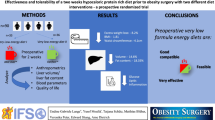Abstract
Purpose
Weight loss before bariatric surgery with a low-calorie diet (LCD) has several advantages, including reduction of liver volume and an improved access to the lesser sac. Disadvantages include performing surgery in a state of undernutrition, side effects, costs and patient compliance. Omega-3 fatty acids may serve as an alternative to reduce liver steatosis.
Materials and Methods
A randomised controlled open-label trial was done to compare the effects of a LCD with Modifast (800 kcal/day) during 2 weeks with 2 g of omega-3 fatty acids a day and a normal diet (2000 kcal/day) during 4 weeks. Total liver volume (TLV) and volume of the left liver lobe (LLL), visceral fat area (VFA) and muscle area (SMA) at the L3–L4 level were measured with MRI before and after preoperative treatment.
Results
Sixty-two morbidly obese women undergoing laparoscopic Roux-en-Y gastric bypass surgery (LRYGB) were recruited. In both groups, there was a significant decrease in LLL, TLV and VFA. For LLL and TLV reduction, the LCD had a significantly larger effect (p < 0.05). Only in the LCD group was there a significant decrease in SMA with significantly more side effects and worse compliance.
Conclusion
Both the LCD and omega-3 diet reduced LLL, TLV and VFA. The LCD outperformed the omega-3 diet in LLL and TLV reduction, but induced significant loss of SMA and had worse compliance due to more side effects. Omega-3 fatty acids may provide a safe and more patient-friendly alternative for a LCD and further research is indicated.
Trial Registration
The study is registered at www.clinicaltrials.gov (NCT02206256).


Similar content being viewed by others
References
Powell MS, Fernandez Jr AZ. Surgical treatment for morbid obesity: the laparoscopic Roux-en-Y gastric bypass. Surg Clin N Am. 2011;91:1203–24. viii
Prado CM, Cushen SJ, Orsso CE, et al. Sarcopenia and cachexia in the era of obesity: clinical and nutritional impact. Proc Nutr Soc. 2016;75:188–98.
Edholm D, Kullberg J, Karlsson FA, et al. Changes in liver volume and body composition during 4 weeks of low calorie diet before laparoscopic gastric bypass. Surg Obes Relat Dis. 2015;11:602–6.
Colles SL, Dixon JB, Marks P, et al. Preoperative weight loss with a very-low-energy diet: quantitation of changes in liver and abdominal fat by serial imaging. Am J Clin Nutr. 2006;84:304–11.
Lewis MC, Phillips ML, Slavotinek JP, et al. Change in liver size and fat content after treatment with Optifast very low calorie diet. Obes Surg. 2006;16:697–701.
Gonzalez-Perez J, Sanchez-Leenheer S, Delgado AR, et al. Clinical impact of a 6-week preoperative very low calorie diet on body weight and liver size in morbidly obese patients. Obes Surg. 2013;23:1624–31.
Jump DB, Lytle KA, Depner CM, et al. Omega-3 polyunsaturated fatty acids as a treatment strategy for nonalcoholic fatty liver disease. Pharmacol Ther. 2017.
Iannelli A, Martini F, Schneck AS, et al. Preoperative 4-week supplementation with omega-3 polyunsaturated fatty acids reduces liver volume and facilitates bariatric surgery in morbidly obese patients. Obes Surg. 2013;23:1761–5.
Jaser N, Mustonen H, Pietila J, et al. Preoperative transabdominal ultrasonography (US) prior to laparoscopic Roux-en-Y gastric bypass (LRYGBP) and laparoscopic sleeve gastrectomy (LSG) in the first 100 operations. Was it beneficial and reliable during the learning curve? Obes Surg. 2012;22:416–21.
Kim B, Tsujimoto T, So R, et al. Changes in muscle strength after diet-induced weight reduction in adult men with obesity: a prospective study. Diabetes Metab Syndr Obes. 2017;10:187–94.
Jeromson S, Gallagher IJ, Galloway SD, et al. Omega-3 fatty acids and skeletal muscle health. Mar Drugs. 2015;13:6977–7004.
Smith GI, Atherton P, Reeds DN, et al. Dietary omega-3 fatty acid supplementation increases the rate of muscle protein synthesis in older adults: a randomized controlled trial. Am J Clin Nutr. 2011;93:402–12.
Smith GI, Julliand S, Reeds DN, et al. Fish oil-derived n-3 PUFA therapy increases muscle mass and function in healthy older adults. Am J Clin Nutr. 2015;102:115–22.
Lalia AZ, Dasari S, Robinson MM, et al. Influence of omega-3 fatty acids on skeletal muscle protein metabolism and mitochondrial bioenergetics in older adults. Aging (AlbanyNY). 2017;9:1096–129.
Sato T, Kameyama T, Ohori T, et al. Effects of eicosapentaenoic acid treatment on epicardial and abdominal visceral adipose tissue volumes in patients with coronary artery disease. J Atheroscler Thromb. 2014;21:1031–43.
Despres JP. Is visceral obesity the cause of the metabolic syndrome? Ann Med. 2006;38:52–63.
Acknowledgments
We thank all of the patients for their participation in this study. We thank the staff of the Dutch Obesity Clinic for their help with recruiting patients. We thank the staff of the Radiology Department for their assistance with the MRI scans. We thank the staff of the Red Cross Hospital Laboratory, Outpatient Clinic and Operation Room for their help with the practical aspects of the study. We thank H.J. Doodeman for his assistance with the statistical plan and analyses.
Author information
Authors and Affiliations
Corresponding author
Ethics declarations
Conflict of Interest
The authors declare that they have no conflict of interest.
Ethical Approval and Informed Consent
All procedures performed in studies involving human participants were in accordance with the ethical standards of the institutional and/or national research committee and with the 1964 Helsinki declaration and its later amendments or comparable ethical standards. Informed consent was obtained from all individual participants included in the study.
Additional information
Publisher’s Note
Springer Nature remains neutral with regard to jurisdictional claims in published maps and institutional affiliations.
Electronic supplementary material
ESM 1
(DOC 36 kb)
Rights and permissions
About this article
Cite this article
Bakker, N., van den Helder, R.S., Geenen, R.W.F. et al. Four Weeks of Preoperative Omega-3 Fatty Acids Reduce Liver Volume: a Randomised Controlled Trial. OBES SURG 29, 2037–2044 (2019). https://doi.org/10.1007/s11695-019-03814-7
Published:
Issue Date:
DOI: https://doi.org/10.1007/s11695-019-03814-7




